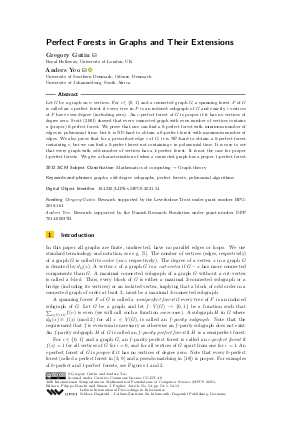Perfect Forests in Graphs and Their Extensions
Authors
Gregory Gutin,
Anders Yeo 
-
Part of:
Volume:
46th International Symposium on Mathematical Foundations of Computer Science (MFCS 2021)
Part of: Series: Leibniz International Proceedings in Informatics (LIPIcs)
Part of: Conference: Mathematical Foundations of Computer Science (MFCS) - License:
 Creative Commons Attribution 4.0 International license
Creative Commons Attribution 4.0 International license
- Publication Date: 2021-08-18
File

PDF
LIPIcs.MFCS.2021.54.pdf
- Filesize: 0.69 MB
- 13 pages
Document Identifiers
Subject Classification
ACM Subject Classification
- Mathematics of computing → Graph theory
Keywords
- graphs
- odd degree subgraphs
- perfect forests
- polynomial algorithms
Metrics
- Access Statistics
-
Total Accesses (updated on a weekly basis)
0PDF Downloads0Metadata Views
Abstract
Let G be a graph on n vertices. For i ∈ {0,1} and a connected graph G, a spanning forest F of G is called an i-perfect forest if every tree in F is an induced subgraph of G and exactly i vertices of F have even degree (including zero). An i-perfect forest of G is proper if it has no vertices of degree zero. Scott (2001) showed that every connected graph with even number of vertices contains a (proper) 0-perfect forest. We prove that one can find a 0-perfect forest with minimum number of edges in polynomial time, but it is NP-hard to obtain a 0-perfect forest with maximum number of edges. We also prove that for a prescribed edge e of G, it is NP-hard to obtain a 0-perfect forest containing e, but we can find a 0-perfect forest not containing e in polynomial time. It is easy to see that every graph with odd number of vertices has a 1-perfect forest. It is not the case for proper 1-perfect forests. We give a characterization of when a connected graph has a proper 1-perfect forest.
Cite As Get BibTex
Gregory Gutin and Anders Yeo. Perfect Forests in Graphs and Their Extensions. In 46th International Symposium on Mathematical Foundations of Computer Science (MFCS 2021). Leibniz International Proceedings in Informatics (LIPIcs), Volume 202, pp. 54:1-54:13, Schloss Dagstuhl – Leibniz-Zentrum für Informatik (2021)
https://doi.org/10.4230/LIPIcs.MFCS.2021.54
BibTex
@InProceedings{gutin_et_al:LIPIcs.MFCS.2021.54,
author = {Gutin, Gregory and Yeo, Anders},
title = {{Perfect Forests in Graphs and Their Extensions}},
booktitle = {46th International Symposium on Mathematical Foundations of Computer Science (MFCS 2021)},
pages = {54:1--54:13},
series = {Leibniz International Proceedings in Informatics (LIPIcs)},
ISBN = {978-3-95977-201-3},
ISSN = {1868-8969},
year = {2021},
volume = {202},
editor = {Bonchi, Filippo and Puglisi, Simon J.},
publisher = {Schloss Dagstuhl -- Leibniz-Zentrum f{\"u}r Informatik},
address = {Dagstuhl, Germany},
URL = {https://drops.dagstuhl.de/entities/document/10.4230/LIPIcs.MFCS.2021.54},
URN = {urn:nbn:de:0030-drops-144947},
doi = {10.4230/LIPIcs.MFCS.2021.54},
annote = {Keywords: graphs, odd degree subgraphs, perfect forests, polynomial algorithms}
}
Author Details
Funding
- Gutin, Gregory: Research supported by the Leverhulme Trust under grant number RPG-2018-161.
- Yeo, Anders: Research supported by the Danish Research Fundation under grant number DFF 7014-00037B.
References
-
Jørgen Bang-Jensen, Eduard Eiben, Gregory Z. Gutin, Magnus Wahlström, and Anders Yeo. Component order connectivity in directed graphs. In Yixin Cao and Marcin Pilipczuk, editors, 15th International Symposium on Parameterized and Exact Computation, IPEC 2020, December 14-18, 2020, Hong Kong, China (Virtual Conference), volume 180 of LIPIcs, pages 2:1-2:16. Schloss Dagstuhl - Leibniz-Zentrum für Informatik, 2020.

- Daniel Bienstock. On the complexity of testing for odd holes and induced odd paths. Discrete Mathematics, 90(1):85-92, 1991. URL: https://doi.org/10.1016/0012-365X(91)90098-M.
-
Yair Caro, Josef Lauri, and Christina Zarb. Two short proofs of the perfect forest theorem. Theory and Applications of Graphs, 4(1), 2017. article 4.

-
Robert Crowston, Mark Jones, and Matthias Mnich. Max-cut parameterized above the Edwards-Erdős bound. Algorithmica, 72(3):734-757, 2015.

-
Reinhard Diestel. Graph Theory, 4th Edition, volume 173 of Graduate texts in mathematics. Springer, 2012.

-
Jörg Flum and Martin Grohe. Parameterized Complexity Theory. Texts in Theoretical Computer Science. An EATCS Series. Springer, 2006.

- Gregory Gutin and Anders Yeo. Lower bounds for Maximum Weighted Cut, 2021. URL: http://arxiv.org/abs/2104.05536.
- Gregory Gutin and Anders Yeo. Perfect forests in graphs and their extensions, 2021. URL: http://arxiv.org/abs/2105.00254v1.
-
Gregory Z. Gutin. Note on perfect forests. J. Graph Theory, 82(3):233-235, 2016.

-
Gregory Z. Gutin and Anders Yeo. Constraint satisfaction problems parameterized above or below tight bounds: A survey. In Hans L. Bodlaender, Rod Downey, Fedor V. Fomin, and Dániel Marx, editors, The Multivariate Algorithmic Revolution and Beyond - Essays Dedicated to Michael R. Fellows on the Occasion of His 60th Birthday, volume 7370 of Lecture Notes in Computer Science, pages 257-286. Springer, 2012.

-
Gregory Z. Gutin and Anders Yeo. Note on perfect forests in digraphs. J. Graph Theory, 85(2):372-377, 2017.

-
John E. Hopcroft and Robert Endre Tarjan. Efficient algorithms for graph manipulation [H] (algorithm 447). Communications of ACM, 16(6):372-378, 1973.

-
Daniel Lokshtanov, N. S. Narayanaswamy, Venkatesh Raman, M. S. Ramanujan, and Saket Saurabh. Faster parameterized algorithms using linear programming. ACM Transactions on Algorithms, 11(2):15:1-15:31, 2014.

-
Daniel Lokshtanov, Saket Saurabh, Roohani Sharma, and Meirav Zehavi. Balanced judicious bipartition is fixed-parameter tractable. SIAM J. Discrete Mathematics, 33(4):1878-1911, 2019.

-
László Lovász and Michael D. Plummer. Matching Theory. Akadémiai Kiadó, 1986.

-
Thomas J. Schaefer. The complexity of satisfiability problems. In Richard J. Lipton, Walter A. Burkhard, Walter J. Savitch, Emily P. Friedman, and Alfred V. Aho, editors, Proceedings of the 10th Annual ACM Symposium on Theory of Computing, May 1-3, 1978, San Diego, California, USA, pages 216-226. ACM, 1978.

-
Alex D. Scott. On induced subgraphs with all degrees odd. Graphs & Combinatorics, 17(3):539-553, 2001.

-
Roded Sharan and Avi Wigderson. A new NCalgorithm for perfect matching in bipartite cubic graphs. In Fourth Israel Symposium on Theory of Computing and Systems, ISTCS 1996, Jerusalem, Israel, June 10-12, 1996, Proceedings, pages 202-207. IEEE Computer Society, 1996.

